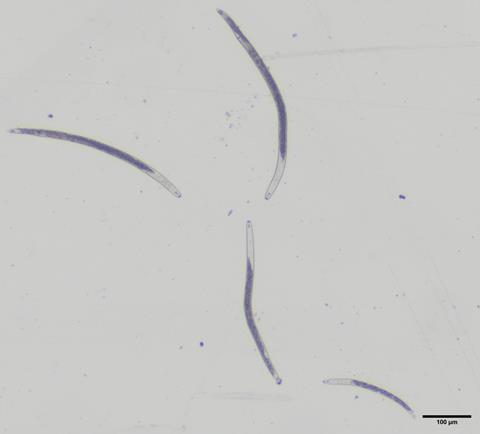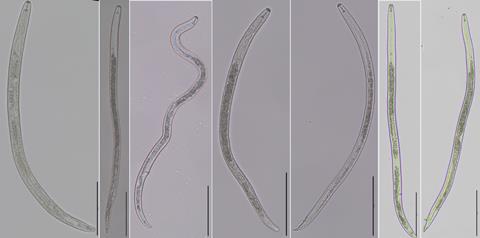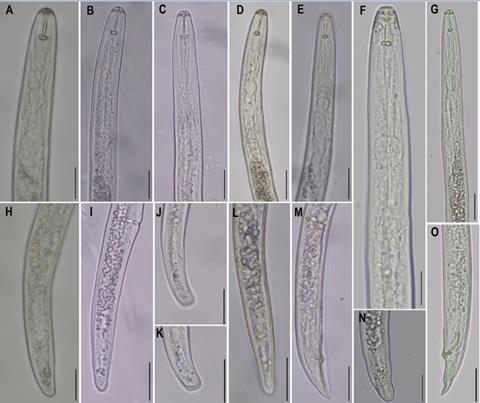A new study has lifted the lid on five species of root-lesion nematodes living in maize crops across New Zealand - and suggested the existence of a hitherto-unsuspected cryptic species.

The article, ‘Molecular characterization of root-lesion nematode, (Pratylenchus spp.) and their prevalence in New Zealand maize fields’, is published in Letters in Applied Microbiology, an Applied Microbiology International publication.
Identifying these nematodes and understanding their distribution will enable targeted pest management strategies, helping to protect crop yields and maintain agricultural productivity, said corresponding author Dr Nagarathnam Thiruchchelvan.
Significant diversity
The study identified and molecularly characterized five species of root-lesion nematodes (Pratylenchus spp.) prevalent in New Zealand maize fields, revealing significant diversity and regional distribution patterns that could impact maize production.
READ MORE: Wild nematode worms learn to avoid harmful bacteria—and their offspring inherit this knowledge
READ MORE: Toxins, E. coli and soil nematodes - Megan reports on her AMI Summer Placement
“Root-lesion nematodes - Pratylenchus spp - are polyphagous pests affecting many crops, including maize. They are known to cause considerable yield losses in cereals worldwide,” Dr Thiruchchelvan said.
“However, their diversity, prevalence, and distribution in New Zealand maize fields were not well understood, making it challenging to implement targeted management strategies. Our research aimed to bridge this gap by identifying the Pratylenchus species present and assessing their distribution across maize-growing regions.”
Nemotode populations
The team conducted molecular and morphological analyses on nematode populations collected from maize fields across New Zealand. Using DNA sequencing with ITS, LSU (D2/D3) and COX1 regions, they identified five species: Pratylenchus neglectus, P. crenatus, P. thornei, P. penetrans, and P. pratensis.

Sequence similarities ranged from 98% to 100%, confirming their identities. Phylogenetic analyses further supported these findings, with all species forming distinct clades.
The results showed that P. neglectus and P. crenatus are the most widespread, while P. thornei, P. pratensis, and P. penetrans were regionally localized. Soil type and cropping history appeared to influence their distribution. For instance, P. penetrans was confined to the Waikato region, while P. thornei and P. pratensis were found primarily in the Canterbury region.
Potential cryptic species
Morphological analysis revealed minor variations in traits like stylet length and tail morphology, potentially due to environmental factors or local adaptation. One surprising discovery was that the P. pratensis population exhibited morphological traits suggesting it might belong to a cryptic species within the P. pratensis complex.
“The discovery of P. pratensis populations with distinct morphological features in New Zealand maize fields was unexpected. These variations, including larger stylet lengths, suggest the possibility of a cryptic species within the P. pratensis complex, highlighting the need for further taxonomic studies,” Dr Thiruchchelvan said.

“Our findings have critical implications for maize production in New Zealand. Pratylenchus species, particularly P. neglectus and P. crenatus, are known to reduce cereal yields significantly. Identifying these nematodes and understanding their distribution will enable targeted pest management strategies, helping to protect crop yields and maintain agricultural productivity.
“Additionally, recognizing the potential for cryptic species within the P. pratensis complex emphasizes the importance of continual monitoring to prevent further spread or emergence of new pest challenges.
The way forward
“Future studies should investigate the impact of these nematodes on maize yield and explore sustainable management strategies, including crop rotation and soil health practices. Morphological and molecular analyses should be expanded to confirm the taxonomic status of P. pratensis populations and determine whether they represent a new species. Integrating root sampling into nematode surveys will provide a more comprehensive understanding of their ecology and behavior in maize fields.”
The study was conducted by Dr Nagarathnam Thiruchchelvan at Lincoln University, New Zealand under the supervision of Dr Manjula Kularathna along with the Co-supervisory team of Dr Romy Moukarzel, Dr Seona Casonato and Prof Leo M Condron. Funding was provided by the PhD scholarship under the AHEAD operation (Round 03-2020, grant number AHEAD/Ph.D./R3/Agri/463) and research funds from Lincoln University, New Zealand (grant number 3601/AGLS/45401/1145841], and the team acknowledge the technical assistance provided by Sandy Hammond with sample collection and Merrick Norma for the sequencing work.
“We also thank the New Zealand maize growers who generously allowed sampling on their land and the team at Pioneer Agricultural Company for their support during the process and perceptions from our colleagues at Lincoln University, New Zealand,” Dr Thiruchchelvan said.
‘Molecular characterization of root-lesion nematode, (Pratylenchus) and their prevalence in New Zealand maize fields’ appears in Letters in Applied Microbiology.
Topics
- Agriculture
- Applied Microbiology International
- Asia & Oceania
- Community
- cryptic species
- Food Security
- Leo M Condron
- Lincoln University
- maize crops
- Manjula Kularathna
- Merrick Norma
- Nagarathnam Thiruchchelvan
- Pioneer Agricultural Company
- Pratylenchus crenatus
- Pratylenchus neglectus
- Pratylenchus penetrans
- Pratylenchus pratensis
- Pratylenchus thornei
- Research News
- Romy Moukarzel
- root-lesion nematodes
- Sandy Hammond
- Seona Casonato
- Soil & Plant Science







No comments yet